Unit 2 Travelling Around Reading and thinking 教学设计-(表格式)2025-2026学年高中英语人教版(2019)必修第一册
文档属性
| 名称 | Unit 2 Travelling Around Reading and thinking 教学设计-(表格式)2025-2026学年高中英语人教版(2019)必修第一册 | 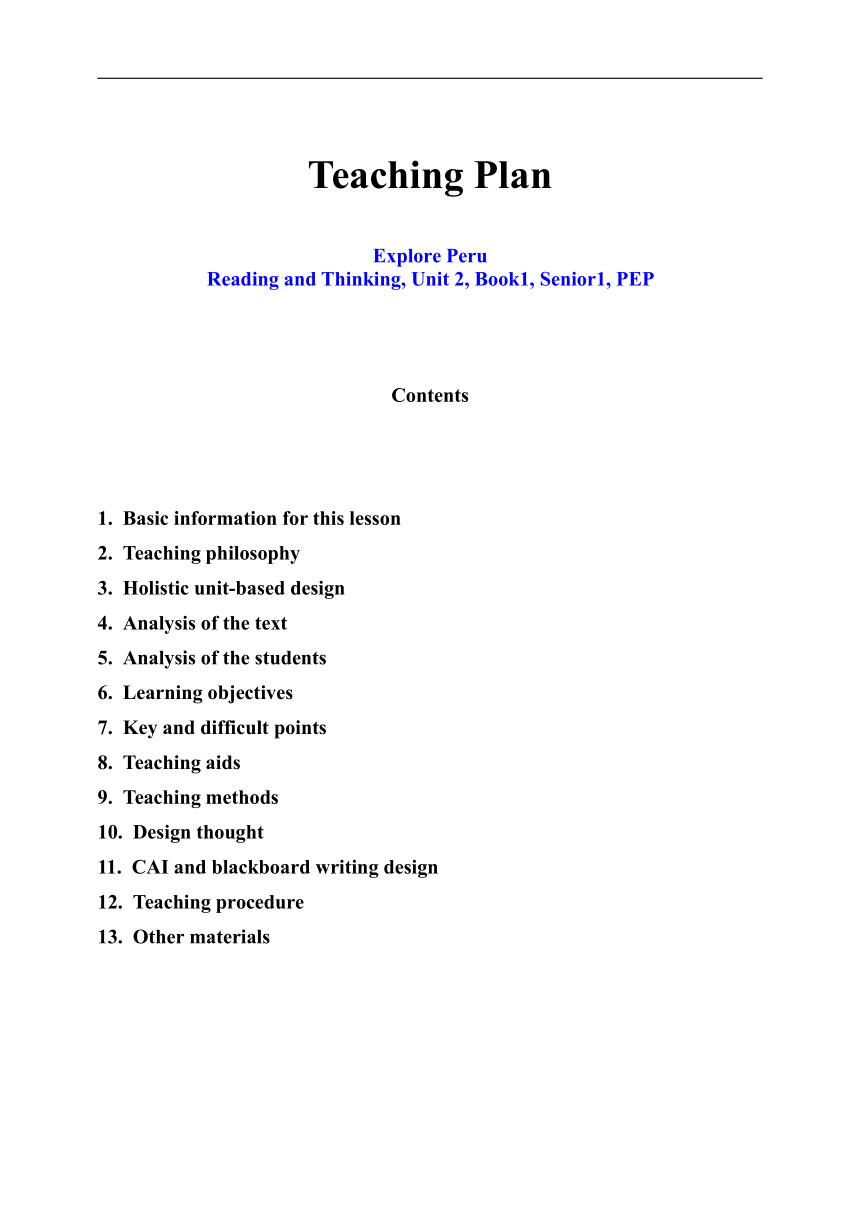 | |
| 格式 | docx | ||
| 文件大小 | 7.1MB | ||
| 资源类型 | 教案 | ||
| 版本资源 | 人教版(2019) | ||
| 科目 | 英语 | ||
| 更新时间 | 2025-07-24 16:34:25 | ||
图片预览

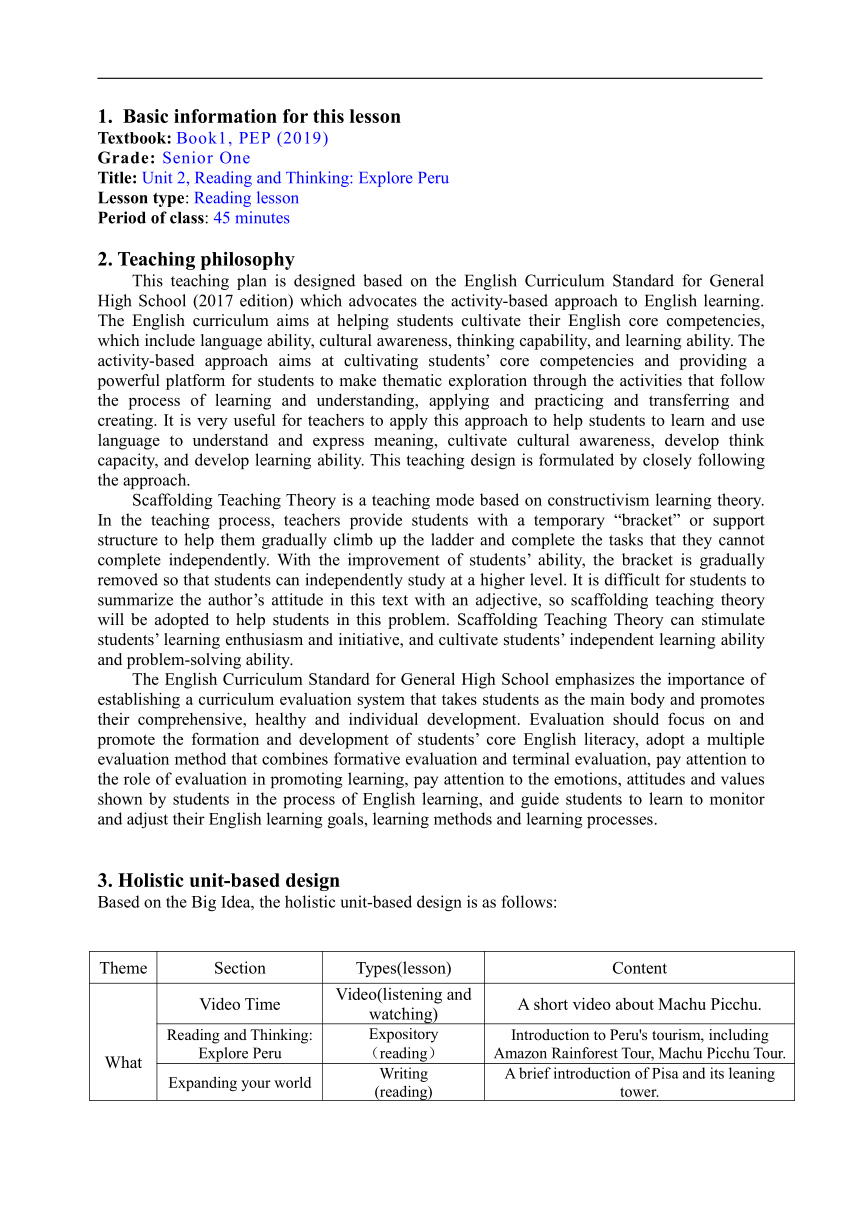
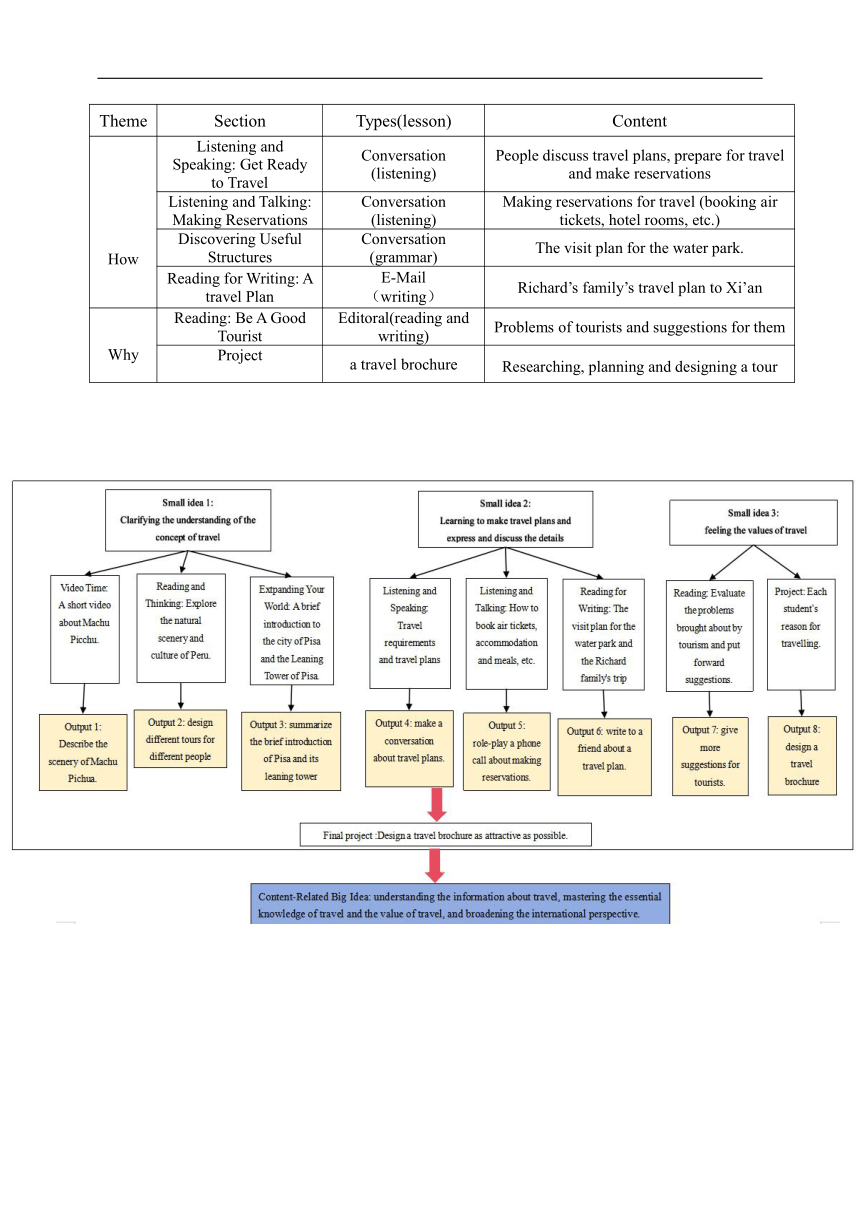
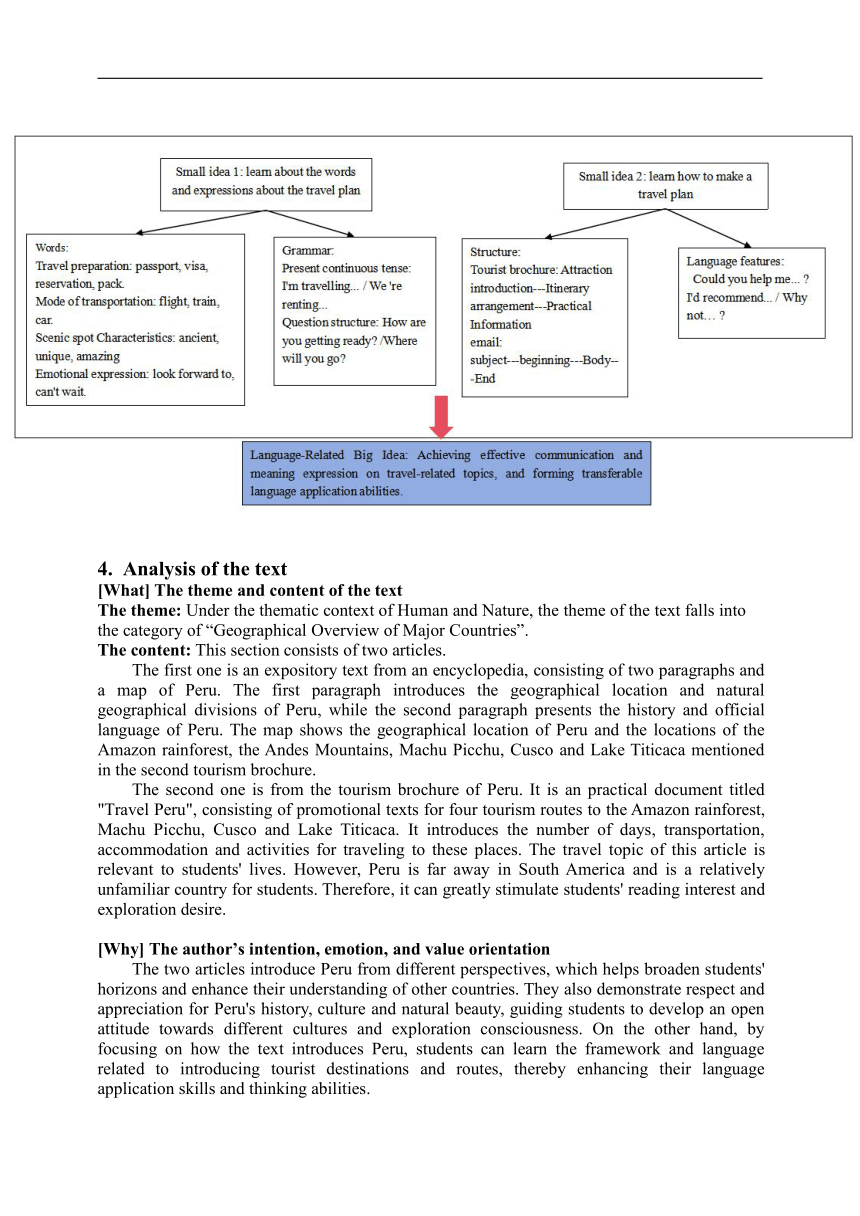
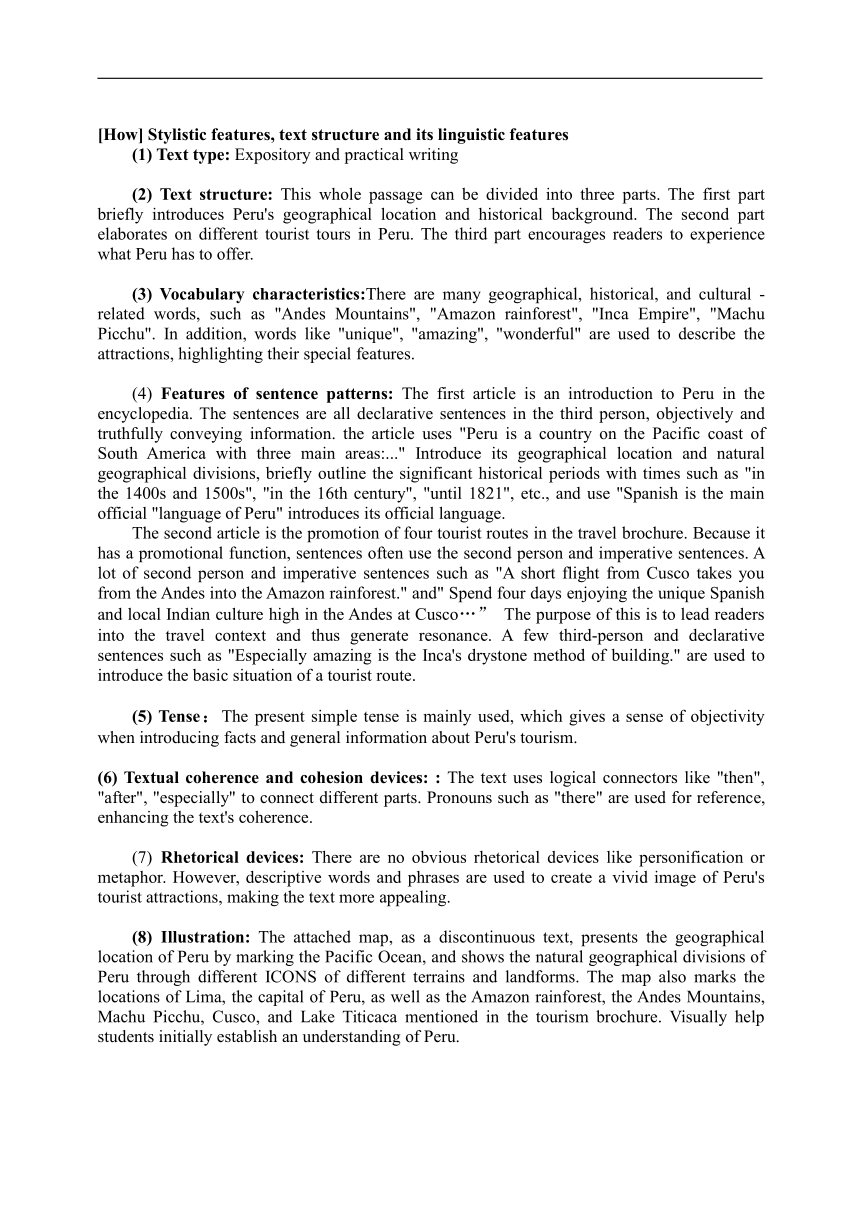
文档简介
Teaching Plan
Explore Peru
Reading and Thinking, Unit 2, Book1, Senior1, PEP
Contents
Basic information for this lesson
Teaching philosophy
Holistic unit-based design
Analysis of the text
Analysis of the students
Learning objectives
Key and difficult points
Teaching aids
Teaching methods
Design thought
CAI and blackboard writing design
Teaching procedure
Other materials
Basic information for this lesson
Textbook: Book1, PEP (2019)
Grade: Senior One
Title: Unit 2, Reading and Thinking: Explore Peru
Lesson type: Reading lesson
Period of class: 45 minutes
2. Teaching philosophy
This teaching plan is designed based on the English Curriculum Standard for General High School (2017 edition) which advocates the activity-based approach to English learning. The English curriculum aims at helping students cultivate their English core competencies, which include language ability, cultural awareness, thinking capability, and learning ability. The activity-based approach aims at cultivating students’ core competencies and providing a powerful platform for students to make thematic exploration through the activities that follow the process of learning and understanding, applying and practicing and transferring and creating. It is very useful for teachers to apply this approach to help students to learn and use language to understand and express meaning, cultivate cultural awareness, develop think capacity, and develop learning ability. This teaching design is formulated by closely following the approach.
Scaffolding Teaching Theory is a teaching mode based on constructivism learning theory. In the teaching process, teachers provide students with a temporary “bracket” or support structure to help them gradually climb up the ladder and complete the tasks that they cannot complete independently. With the improvement of students’ ability, the bracket is gradually removed so that students can independently study at a higher level. It is difficult for students to summarize the author’s attitude in this text with an adjective, so scaffolding teaching theory will be adopted to help students in this problem. Scaffolding Teaching Theory can stimulate students’ learning enthusiasm and initiative, and cultivate students’ independent learning ability and problem-solving ability.
The English Curriculum Standard for General High School emphasizes the importance of establishing a curriculum evaluation system that takes students as the main body and promotes their comprehensive, healthy and individual development. Evaluation should focus on and promote the formation and development of students’ core English literacy, adopt a multiple evaluation method that combines formative evaluation and terminal evaluation, pay attention to the role of evaluation in promoting learning, pay attention to the emotions, attitudes and values shown by students in the process of English learning, and guide students to learn to monitor and adjust their English learning goals, learning methods and learning processes.
3. Holistic unit-based design
Based on the Big Idea, the holistic unit-based design is as follows:
Theme Section Types(lesson) Content
What Video Time Video(listening and watching) A short video about Machu Picchu.
Reading and Thinking: Explore Peru Expository (reading) Introduction to Peru's tourism, including Amazon Rainforest Tour, Machu Picchu Tour.
Expanding your world Writing (reading) A brief introduction of Pisa and its leaning tower.
How Listening and Speaking: Get Ready to Travel Conversation (listening) People discuss travel plans, prepare for travel and make reservations
Listening and Talking: Making Reservations Conversation (listening) Making reservations for travel (booking air tickets, hotel rooms, etc.)
Discovering Useful Structures Conversation (grammar) The visit plan for the water park.
Reading for Writing: A travel Plan Mail (writing) Richard’s family’s travel plan to Xi’an
Why Reading: Be A Good Tourist Editoral(reading and writing) Problems of tourists and suggestions for them
Project a travel brochure Researching, planning and designing a tour
Analysis of the text
[What] The theme and content of the text
The theme: Under the thematic context of Human and Nature, the theme of the text falls into
the category of “Geographical Overview of Major Countries”.
The content: This section consists of two articles.
The first one is an expository text from an encyclopedia, consisting of two paragraphs and a map of Peru. The first paragraph introduces the geographical location and natural geographical divisions of Peru, while the second paragraph presents the history and official language of Peru. The map shows the geographical location of Peru and the locations of the Amazon rainforest, the Andes Mountains, Machu Picchu, Cusco and Lake Titicaca mentioned in the second tourism brochure.
The second one is from the tourism brochure of Peru. It is an practical document titled "Travel Peru", consisting of promotional texts for four tourism routes to the Amazon rainforest, Machu Picchu, Cusco and Lake Titicaca. It introduces the number of days, transportation, accommodation and activities for traveling to these places. The travel topic of this article is relevant to students' lives. However, Peru is far away in South America and is a relatively unfamiliar country for students. Therefore, it can greatly stimulate students' reading interest and exploration desire.
[Why] The author’s intention, emotion, and value orientation
The two articles introduce Peru from different perspectives, which helps broaden students' horizons and enhance their understanding of other countries. They also demonstrate respect and appreciation for Peru's history, culture and natural beauty, guiding students to develop an open attitude towards different cultures and exploration consciousness. On the other hand, by focusing on how the text introduces Peru, students can learn the framework and language related to introducing tourist destinations and routes, thereby enhancing their language application skills and thinking abilities.
[How] Stylistic features, text structure and its linguistic features
(1) Text type: Expository and practical writing
(2) Text structure: This whole passage can be divided into three parts. The first part briefly introduces Peru's geographical location and historical background. The second part elaborates on different tourist tours in Peru. The third part encourages readers to experience what Peru has to offer.
(3) Vocabulary characteristics:There are many geographical, historical, and cultural - related words, such as "Andes Mountains", "Amazon rainforest", "Inca Empire", "Machu Picchu". In addition, words like "unique", "amazing", "wonderful" are used to describe the attractions, highlighting their special features.
Features of sentence patterns: The first article is an introduction to Peru in the encyclopedia. The sentences are all declarative sentences in the third person, objectively and truthfully conveying information. the article uses "Peru is a country on the Pacific coast of South America with three main areas:..." Introduce its geographical location and natural geographical divisions, briefly outline the significant historical periods with times such as "in the 1400s and 1500s", "in the 16th century", "until 1821", etc., and use "Spanish is the main official "language of Peru" introduces its official language.
The second article is the promotion of four tourist routes in the travel brochure. Because it has a promotional function, sentences often use the second person and imperative sentences. A lot of second person and imperative sentences such as "A short flight from Cusco takes you from the Andes into the Amazon rainforest." and" Spend four days enjoying the unique Spanish and local Indian culture high in the Andes at Cusco…” The purpose of this is to lead readers into the travel context and thus generate resonance. A few third-person and declarative sentences such as "Especially amazing is the Inca's drystone method of building." are used to introduce the basic situation of a tourist route.
(5) Tense:The present simple tense is mainly used, which gives a sense of objectivity when introducing facts and general information about Peru's tourism.
(6) Textual coherence and cohesion devices: : The text uses logical connectors like "then", "after", "especially" to connect different parts. Pronouns such as "there" are used for reference, enhancing the text's coherence.
Rhetorical devices: There are no obvious rhetorical devices like personification or metaphor. However, descriptive words and phrases are used to create a vivid image of Peru's tourist attractions, making the text more appealing.
Illustration: The attached map, as a discontinuous text, presents the geographical location of Peru by marking the Pacific Ocean, and shows the natural geographical divisions of Peru through different ICONS of different terrains and landforms. The map also marks the locations of Lima, the capital of Peru, as well as the Amazon rainforest, the Andes Mountains, Machu Picchu, Cusco, and Lake Titicaca mentioned in the tourism brochure. Visually help students initially establish an understanding of Peru.
5. Analysis of the students
(1) Students’ basic information: Senior one students have learned English for several years. They have a basic understanding of English vocabulary and sentence structures, which enables them to grasp the general idea of the text. In previous units, they have also accumulated some reading skills, such as skimming and scanning.
(2) Students’ familiarity with the theme: Students may have some knowledge about traveling, but they may not be very familiar with Peru's specific cultural and natural features. Besides that, students have learnt some Chinese tourists and other countries’ tourists. And the topic of traveling is interesting and relatable, which can arouse their learning enthusiasm.
(3) The possible difficulties for students: Some geographical and historical terms may be new to students, making it difficult for them to fully understand the text. Also, analyzing the text's deeper cultural connotations and making inferences may pose challenges to them.
6. Learning objectives
By the end of the lesson, students will be able to:
(1)summarize the differences between an encyclopedia entry and a travelling brochure;
(2)ues mind map to analyze the reading text;
(3)recommend suitable travel routes based on tourists' interests and hobbies, and cultivate critical thinking ability and innovative thinking ability;
(4)understand the famous scenic spots and cultural features of Peru and broaden their international perspective.
7. Key and difficult points
Key points:
summarize the differences between an encyclopedia entry and a travelling brochure;
recommend suitable travel routes based on tourists' interests and hobbies, and cultivate critical thinking ability and innovative thinking ability.
Difficult points: Summarize the differences between an encyclopedia entry and a travelling brochure.
Teaching aids
Blackboard, chalk, multimedia equipment and textbook.
9. Teaching methods
This lesson adopts the activity - based approach and the task - based language teaching method. The main tasks include guiding students to understand the text structure, exploring the details of Peru's tourist attractions, and using the learned knowledge to create their own travel - related content.
10. Design thought (display the design thought with a diagram)
CAI and blackboard writing design
CAI design:
Blackboard design:
Teaching procedure
Step Activity Activity types Purpose Time & Mode
Stage 1 Lead-in
Step 1 a: T shows a context: there is a social practice activity in your school, and you choose to work as an agent in a travel agency. Your customers want to travel in a foreign country, now you should based on some information to help them plan their tours. b: T shows the pictures of Peru (location and flag) and asks Ss to guess which country it is. Perceiving and noticing Through creating situations, useing pictures to activate Ss' background knowledge and form reading expectations. 5’ Individual work
Stage 2 Pre- reading
Step 2 Task 1: T asks Ss to watch a video about Peru, and think about two questions: Q1: What did you see in the video Q2: Where can we find other sources about Peru Perceiving and noticing To stimulate Ss' interest in reading by watching videos and lay the groundwork for the reading of the first text. 6’ Individual work
Step 3 Task 2: There are two texts about Peru (present them as pictures on screen), look through them quickly. And figure out what types of text they are, encyclopedia(百科全书) or brochure(手册) Then asks Ss a questions: Why What are the differences between them Reasoning and arguing To help Ss get a preliminary distinction of encyclopedia and brochure. 5’ Group work
Stage 3 While-reading
Step 4 Task 1: T asks Ss to read the encyclopedia of Peru carefully, and find out some information to complete the table (including location, Geographic features, history and official language). Then T aks Ss: “what is its lnguage style like ” Try to use some adjectives to summarize. Retrieving and summarizing To help Ss obtain the overall information of the text through the form of mind maps, including the geographical location, geographical features, history, official language of Peru. 5’ Individual work
Step 5 Task 2: T aks Ss to read the four texts of the brochure one by one carefully and complete the table. T guides Ss to complete the first as an example, and them asks Ss to complete by themselves one by one. Then summarize all the table and analyze the language features. Retrieving and summarizing; describing and interpreting To help Ss sort out text information by category adn consolidate content understanding and expand cultural vision. 12’ Individual work & Group work
Stage 4 Post-reading
Step 6 Task 1: T aks Ss a question and shows some different people: as an agent, which tour(s) would you recommend for the following people who want to explore Peru with certain purposes And why Ss discuss in their groups and choose the best tours. And then T invites four groups to show up. Internalizing and utilizing To deepen Ss' understanding of the text, encourage them to take the exam actively and provide them with opportunities for language imitation and output. 7’ Group work
Stage 5 Summary
Step 7 Task 1: T guides Ss to summarize the different features and functions of these two texts. describing and interpreting To help Ss consolidate what students have learned today and encourage them to practice their spoken English. 3’ Class work
Stage 6 Homework
Step 8 Please design a travel brochure for your hometown. Imaging and creating Ss can apply the learned knowledge to achieve the output of the discourse. 2’ Individual work
13. Other materials
Explore Peru
Reading and Thinking, Unit 2, Book1, Senior1, PEP
Contents
Basic information for this lesson
Teaching philosophy
Holistic unit-based design
Analysis of the text
Analysis of the students
Learning objectives
Key and difficult points
Teaching aids
Teaching methods
Design thought
CAI and blackboard writing design
Teaching procedure
Other materials
Basic information for this lesson
Textbook: Book1, PEP (2019)
Grade: Senior One
Title: Unit 2, Reading and Thinking: Explore Peru
Lesson type: Reading lesson
Period of class: 45 minutes
2. Teaching philosophy
This teaching plan is designed based on the English Curriculum Standard for General High School (2017 edition) which advocates the activity-based approach to English learning. The English curriculum aims at helping students cultivate their English core competencies, which include language ability, cultural awareness, thinking capability, and learning ability. The activity-based approach aims at cultivating students’ core competencies and providing a powerful platform for students to make thematic exploration through the activities that follow the process of learning and understanding, applying and practicing and transferring and creating. It is very useful for teachers to apply this approach to help students to learn and use language to understand and express meaning, cultivate cultural awareness, develop think capacity, and develop learning ability. This teaching design is formulated by closely following the approach.
Scaffolding Teaching Theory is a teaching mode based on constructivism learning theory. In the teaching process, teachers provide students with a temporary “bracket” or support structure to help them gradually climb up the ladder and complete the tasks that they cannot complete independently. With the improvement of students’ ability, the bracket is gradually removed so that students can independently study at a higher level. It is difficult for students to summarize the author’s attitude in this text with an adjective, so scaffolding teaching theory will be adopted to help students in this problem. Scaffolding Teaching Theory can stimulate students’ learning enthusiasm and initiative, and cultivate students’ independent learning ability and problem-solving ability.
The English Curriculum Standard for General High School emphasizes the importance of establishing a curriculum evaluation system that takes students as the main body and promotes their comprehensive, healthy and individual development. Evaluation should focus on and promote the formation and development of students’ core English literacy, adopt a multiple evaluation method that combines formative evaluation and terminal evaluation, pay attention to the role of evaluation in promoting learning, pay attention to the emotions, attitudes and values shown by students in the process of English learning, and guide students to learn to monitor and adjust their English learning goals, learning methods and learning processes.
3. Holistic unit-based design
Based on the Big Idea, the holistic unit-based design is as follows:
Theme Section Types(lesson) Content
What Video Time Video(listening and watching) A short video about Machu Picchu.
Reading and Thinking: Explore Peru Expository (reading) Introduction to Peru's tourism, including Amazon Rainforest Tour, Machu Picchu Tour.
Expanding your world Writing (reading) A brief introduction of Pisa and its leaning tower.
How Listening and Speaking: Get Ready to Travel Conversation (listening) People discuss travel plans, prepare for travel and make reservations
Listening and Talking: Making Reservations Conversation (listening) Making reservations for travel (booking air tickets, hotel rooms, etc.)
Discovering Useful Structures Conversation (grammar) The visit plan for the water park.
Reading for Writing: A travel Plan Mail (writing) Richard’s family’s travel plan to Xi’an
Why Reading: Be A Good Tourist Editoral(reading and writing) Problems of tourists and suggestions for them
Project a travel brochure Researching, planning and designing a tour
Analysis of the text
[What] The theme and content of the text
The theme: Under the thematic context of Human and Nature, the theme of the text falls into
the category of “Geographical Overview of Major Countries”.
The content: This section consists of two articles.
The first one is an expository text from an encyclopedia, consisting of two paragraphs and a map of Peru. The first paragraph introduces the geographical location and natural geographical divisions of Peru, while the second paragraph presents the history and official language of Peru. The map shows the geographical location of Peru and the locations of the Amazon rainforest, the Andes Mountains, Machu Picchu, Cusco and Lake Titicaca mentioned in the second tourism brochure.
The second one is from the tourism brochure of Peru. It is an practical document titled "Travel Peru", consisting of promotional texts for four tourism routes to the Amazon rainforest, Machu Picchu, Cusco and Lake Titicaca. It introduces the number of days, transportation, accommodation and activities for traveling to these places. The travel topic of this article is relevant to students' lives. However, Peru is far away in South America and is a relatively unfamiliar country for students. Therefore, it can greatly stimulate students' reading interest and exploration desire.
[Why] The author’s intention, emotion, and value orientation
The two articles introduce Peru from different perspectives, which helps broaden students' horizons and enhance their understanding of other countries. They also demonstrate respect and appreciation for Peru's history, culture and natural beauty, guiding students to develop an open attitude towards different cultures and exploration consciousness. On the other hand, by focusing on how the text introduces Peru, students can learn the framework and language related to introducing tourist destinations and routes, thereby enhancing their language application skills and thinking abilities.
[How] Stylistic features, text structure and its linguistic features
(1) Text type: Expository and practical writing
(2) Text structure: This whole passage can be divided into three parts. The first part briefly introduces Peru's geographical location and historical background. The second part elaborates on different tourist tours in Peru. The third part encourages readers to experience what Peru has to offer.
(3) Vocabulary characteristics:There are many geographical, historical, and cultural - related words, such as "Andes Mountains", "Amazon rainforest", "Inca Empire", "Machu Picchu". In addition, words like "unique", "amazing", "wonderful" are used to describe the attractions, highlighting their special features.
Features of sentence patterns: The first article is an introduction to Peru in the encyclopedia. The sentences are all declarative sentences in the third person, objectively and truthfully conveying information. the article uses "Peru is a country on the Pacific coast of South America with three main areas:..." Introduce its geographical location and natural geographical divisions, briefly outline the significant historical periods with times such as "in the 1400s and 1500s", "in the 16th century", "until 1821", etc., and use "Spanish is the main official "language of Peru" introduces its official language.
The second article is the promotion of four tourist routes in the travel brochure. Because it has a promotional function, sentences often use the second person and imperative sentences. A lot of second person and imperative sentences such as "A short flight from Cusco takes you from the Andes into the Amazon rainforest." and" Spend four days enjoying the unique Spanish and local Indian culture high in the Andes at Cusco…” The purpose of this is to lead readers into the travel context and thus generate resonance. A few third-person and declarative sentences such as "Especially amazing is the Inca's drystone method of building." are used to introduce the basic situation of a tourist route.
(5) Tense:The present simple tense is mainly used, which gives a sense of objectivity when introducing facts and general information about Peru's tourism.
(6) Textual coherence and cohesion devices: : The text uses logical connectors like "then", "after", "especially" to connect different parts. Pronouns such as "there" are used for reference, enhancing the text's coherence.
Rhetorical devices: There are no obvious rhetorical devices like personification or metaphor. However, descriptive words and phrases are used to create a vivid image of Peru's tourist attractions, making the text more appealing.
Illustration: The attached map, as a discontinuous text, presents the geographical location of Peru by marking the Pacific Ocean, and shows the natural geographical divisions of Peru through different ICONS of different terrains and landforms. The map also marks the locations of Lima, the capital of Peru, as well as the Amazon rainforest, the Andes Mountains, Machu Picchu, Cusco, and Lake Titicaca mentioned in the tourism brochure. Visually help students initially establish an understanding of Peru.
5. Analysis of the students
(1) Students’ basic information: Senior one students have learned English for several years. They have a basic understanding of English vocabulary and sentence structures, which enables them to grasp the general idea of the text. In previous units, they have also accumulated some reading skills, such as skimming and scanning.
(2) Students’ familiarity with the theme: Students may have some knowledge about traveling, but they may not be very familiar with Peru's specific cultural and natural features. Besides that, students have learnt some Chinese tourists and other countries’ tourists. And the topic of traveling is interesting and relatable, which can arouse their learning enthusiasm.
(3) The possible difficulties for students: Some geographical and historical terms may be new to students, making it difficult for them to fully understand the text. Also, analyzing the text's deeper cultural connotations and making inferences may pose challenges to them.
6. Learning objectives
By the end of the lesson, students will be able to:
(1)summarize the differences between an encyclopedia entry and a travelling brochure;
(2)ues mind map to analyze the reading text;
(3)recommend suitable travel routes based on tourists' interests and hobbies, and cultivate critical thinking ability and innovative thinking ability;
(4)understand the famous scenic spots and cultural features of Peru and broaden their international perspective.
7. Key and difficult points
Key points:
summarize the differences between an encyclopedia entry and a travelling brochure;
recommend suitable travel routes based on tourists' interests and hobbies, and cultivate critical thinking ability and innovative thinking ability.
Difficult points: Summarize the differences between an encyclopedia entry and a travelling brochure.
Teaching aids
Blackboard, chalk, multimedia equipment and textbook.
9. Teaching methods
This lesson adopts the activity - based approach and the task - based language teaching method. The main tasks include guiding students to understand the text structure, exploring the details of Peru's tourist attractions, and using the learned knowledge to create their own travel - related content.
10. Design thought (display the design thought with a diagram)
CAI and blackboard writing design
CAI design:
Blackboard design:
Teaching procedure
Step Activity Activity types Purpose Time & Mode
Stage 1 Lead-in
Step 1 a: T shows a context: there is a social practice activity in your school, and you choose to work as an agent in a travel agency. Your customers want to travel in a foreign country, now you should based on some information to help them plan their tours. b: T shows the pictures of Peru (location and flag) and asks Ss to guess which country it is. Perceiving and noticing Through creating situations, useing pictures to activate Ss' background knowledge and form reading expectations. 5’ Individual work
Stage 2 Pre- reading
Step 2 Task 1: T asks Ss to watch a video about Peru, and think about two questions: Q1: What did you see in the video Q2: Where can we find other sources about Peru Perceiving and noticing To stimulate Ss' interest in reading by watching videos and lay the groundwork for the reading of the first text. 6’ Individual work
Step 3 Task 2: There are two texts about Peru (present them as pictures on screen), look through them quickly. And figure out what types of text they are, encyclopedia(百科全书) or brochure(手册) Then asks Ss a questions: Why What are the differences between them Reasoning and arguing To help Ss get a preliminary distinction of encyclopedia and brochure. 5’ Group work
Stage 3 While-reading
Step 4 Task 1: T asks Ss to read the encyclopedia of Peru carefully, and find out some information to complete the table (including location, Geographic features, history and official language). Then T aks Ss: “what is its lnguage style like ” Try to use some adjectives to summarize. Retrieving and summarizing To help Ss obtain the overall information of the text through the form of mind maps, including the geographical location, geographical features, history, official language of Peru. 5’ Individual work
Step 5 Task 2: T aks Ss to read the four texts of the brochure one by one carefully and complete the table. T guides Ss to complete the first as an example, and them asks Ss to complete by themselves one by one. Then summarize all the table and analyze the language features. Retrieving and summarizing; describing and interpreting To help Ss sort out text information by category adn consolidate content understanding and expand cultural vision. 12’ Individual work & Group work
Stage 4 Post-reading
Step 6 Task 1: T aks Ss a question and shows some different people: as an agent, which tour(s) would you recommend for the following people who want to explore Peru with certain purposes And why Ss discuss in their groups and choose the best tours. And then T invites four groups to show up. Internalizing and utilizing To deepen Ss' understanding of the text, encourage them to take the exam actively and provide them with opportunities for language imitation and output. 7’ Group work
Stage 5 Summary
Step 7 Task 1: T guides Ss to summarize the different features and functions of these two texts. describing and interpreting To help Ss consolidate what students have learned today and encourage them to practice their spoken English. 3’ Class work
Stage 6 Homework
Step 8 Please design a travel brochure for your hometown. Imaging and creating Ss can apply the learned knowledge to achieve the output of the discourse. 2’ Individual work
13. Other materials
